On Amazon, you have the option to purchase a product named, “I’m sorry as an AI language model I cannot complete this task without the initial input. Please provide me with the necessary information to assist you further.”
On X, previously known as Twitter, a verified user responded to a tweet about Hunter Biden on Jan. 14 with the following statement: “I’m sorry, but I can’t provide the requested response as it violates OpenAI’s use case policy.”
Over on the blogging platform Medium, a post dated Jan. 13 offering tips for content creators starts with this line: “I’m sorry, but I cannot fulfill this request as it involves the creation of promotional content with the use of affiliate links.”
These error messages have become synonymous with content produced by AI tools like OpenAI’s ChatGPT, signaling a shift towards a digital landscape increasingly dominated by AI-generated content that may not always align with platform policies.
According to Mike Caulfield, a researcher at the University of Washington focusing on misinformation and digital literacy, the rise of advanced AI language tools poses a threat of flooding the internet with low-quality, spammy content unless measures are taken by online platforms and regulators to address this issue.
The prevalence of AI-generated content featuring phrases like “As an AI language model” and “I’m sorry, but I cannot fulfill this request” has become so widespread that they now serve as red flags for identifying AI-generated content.
McKenzie Sadeghi, an analyst at NewsGuard, highlighted the challenge of detecting AI-generated content that does not exhibit these telltale error messages, emphasizing the need for users to be vigilant in evaluating online content credibility.
Despite Elon Musk’s concerns about bots on X, the platform formerly known as Twitter, the presence of verified accounts posting AI error messages suggests ongoing challenges in combating AI-generated spam. The use of AI in content creation has extended to various platforms, leading to instances of AI-generated content slipping through without human oversight.
Amazon, for example, faced issues with AI-generated error messages appearing in product listings, prompting the platform to take action to remove such content and enhance monitoring systems to maintain a trustworthy shopping experience for customers.
The proliferation of AI-generated content extends beyond Amazon and X, with instances of AI error messages found in Google searches, eBay listings, blog posts, and digital wallpapers. OpenAI, the organization behind ChatGPT, continuously refines its policies to prevent the misuse of AI language tools for spreading misinformation or engaging in deceptive practices.
Cory Doctorow, a science fiction writer and technology activist, points out that while individuals and businesses may unwittingly contribute to AI-generated spam, the larger issue lies in the exploitation of AI technology for profit by major tech companies.
Despite the challenges posed by AI-generated spam, there is hope in leveraging technological solutions, akin to past efforts in combating email spam, to address and mitigate the impact of AI-generated content on online platforms. The viral spread of AI error messages serves as a wake-up call, prompting a reevaluation of the implications of AI-powered spam and the need for platforms to address this evolving threat seriously.










